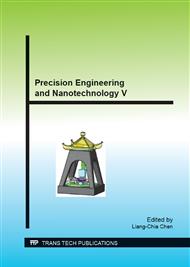p.496
p.505
p.511
p.518
p.525
p.530
p.536
p.545
p.550
Molecular Dynamics Simulation of Pressure Generated inside Melting Area in EDM
Abstract:
Electrical discharge phenomena in EDM occur in a very short time period and in a very narrow space, thus making both observation and theoretical analysis extremely difficult. For this reason, the material removal mechanism in EDM has yet to be understood clearly. EDM is a thermal process. Thermal energy is generated by a pulse discharge between the workpiece and the tool electrode. It results in melting and evaporating followed by removal of both the workpiece and tool electrode, forming a discharge crater on both surfaces. In this paper, the hydrostatic pressure distribution in melting area was simulated by Molecular Dynamics (MD) methods. The analysis shows that after discharge is ignited, extremely high pressure is generated inside the melting area. The pressure distribution along the central axis of the melting area at different times indicates that during the discharge duration, the hydrostatic pressure quickly increases to a peak value along the depth direction of melting area and then reduced to 0 GPa in the unaffected area. It was also found that with the passage of time, the depth of the point where the pressure peaks increases with the formation of the discharge crater, accompanied by the decrease in the peak pressure. In addition, the ejected material atoms at different times during the removal process were also analyzed. It was found that the material ablation occurs mostly during the discharge duration.
Info:
Periodical:
Pages:
525-529
Citation:
Online since:
August 2014
Authors:
Price:
Сopyright:
© 2015 Trans Tech Publications Ltd. All Rights Reserved
Share:
Citation:


